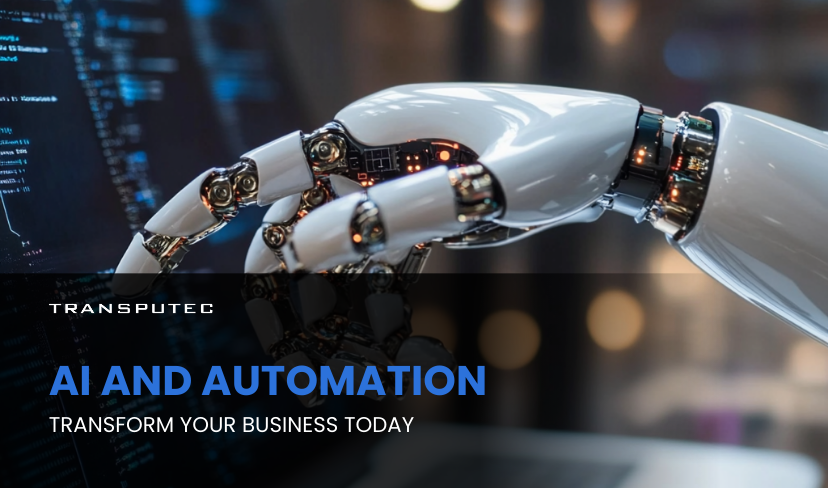Written by KRITIKA SINHA | MARKETING
Imagine a business owner juggling countless tasks—managing operations, ensuring customer satisfaction, and keeping costs under control—all while trying to stay ahead of competitors. Employees, too, often find themselves bogged down with repetitive tasks that leave little room for creativity or strategic thinking. These challenges are not just frustrating; they hinder growth and innovation. Enter AI and Automation, the game-changing duo that promises to revolutionise how businesses operate.
This blog explores how AI and Automation can help businesses achieve more with fewer resources. From streamlining processes to enhancing decision-making, we’ll delve into actionable insights, real-world applications, and strategies to maximise their benefits. Whether you’re a small business or a large enterprise, understanding AI and Automation could be your key to thriving in a competitive market.
What Are AI and Automation?
AI (Artificial Intelligence) refers to machines mimicking human intelligence to perform tasks such as learning, reasoning, and problem-solving. Automation involves using technology to execute repetitive tasks with minimal human intervention. Together, these technologies enable businesses to optimise operations, reduce costs, and drive innovation.
Transputec is a leading IT services provider specialising in AI solutions tailored to meet the unique needs of businesses. With decades of experience and a team of experts, Transputec empowers organisations to harness the potential of AI technologies, streamline operations, and drive innovation.
Explain 5 Key Benefits of AI and Automation
AI and Automation are transforming businesses across industries, delivering measurable improvements in efficiency, cost savings, decision-making, and customer satisfaction. Below are five key benefits supported by empirical data and real-world applications:
1. Increased Efficiency
AI and Automation streamline repetitive tasks such as data entry, scheduling, and reporting, freeing up employees to focus on more strategic work. According to McKinsey & Company, automation can boost productivity by up to 30% For example:
- AI-powered tools optimise workflows, reducing turnaround times for customer enquiries and internal processes.
- Automated systems improve service level agreements (SLAs) and key performance indicators (KPIs), offering faster results with fewer resources.
2. Cost Savings
Automating processes significantly reduces operational costs by minimising labour expenses, energy consumption, and waste. A Deloitte survey revealed that businesses adopting intelligent automation reported an average cost savings of 32%. Specific applications include:
- Predictive maintenance systems that detect equipment issues early reduce downtime and repair costs.
- AI-driven inventory management that optimises stock levels to avoid overstocking or shortages.
3. Improved Accuracy
AI eliminates human error in tasks like data analysis and document processing. A study by Nintex found that 76% of organisations experienced enhanced accuracy after implementing automation. Examples include:
- AI algorithms ensure precise financial transactions.
- Automated quality control systems identifying defects in manufacturing processes.
4. Enhanced Customer Engagement
AI-powered chatbots and virtual assistants provide personalised, 24/7 customer support. HubSpot reported that 55% of customers prefer interacting with businesses via AI-driven messaging apps. Benefits include:
- Instant responses to enquiries, improving satisfaction rates.
- Sentiment analysis tools that tailor interactions based on customer emotions.
5. Data-Driven Decision-Making
AI excels at analysing large datasets to uncover trends, predict future behaviours, and offer actionable insights. Businesses using AI for decision-making are 1.8 times more likely to achieve real-time visibility into performance metrics. Applications include:
- Predictive analytics for market trends and consumer behaviour forecasting.
- Strategic recommendations based on historical and real-time data analysis.
These benefits highlight why businesses worldwide are embracing AI and Automation as critical tools for growth and innovation.
Challenges of Implementing AI and Automation
While AI and Automation offer transformative benefits for businesses, their implementation is often fraught with challenges. Addressing these obstacles proactively is essential for successful adoption. Below are five key challenges organisations face when integrating AI and Automation into their operations:
1. Data Availability and Quality
AI systems rely heavily on high-quality, accurate, and comprehensive data to function effectively. However, many businesses struggle with:
- Inadequate Data: Insufficient or incomplete datasets can lead to inaccurate predictions and poor decision-making.
- Data Bias: Low-quality or biased data can skew AI outputs, resulting in unfair or unreliable results.
Solution: Businesses must invest in data management processes such as cleansing, normalisation, and enrichment. Leveraging external data sources to supplement internal datasets can also ensure better outcomes.
2. Integration with Existing Systems
Integrating AI with legacy systems is a significant technical challenge. Many older infrastructures lack compatibility with modern AI technologies, leading to:
- Operational Disruptions: Implementing AI may temporarily disrupt workflows.
- Technical Limitations: Outdated systems may hinder the full potential of AI applications.
Solution: Conduct a comprehensive assessment of existing infrastructure and partner with experienced AI consultants to ensure seamless integration. Employee training on new systems also helps mitigate disruptions.
3. Employee Resistance
Employees often fear that automation will replace their roles or increase surveillance, leading to resistance. A 2023 PwC survey revealed that 54% of workers worry about job displacement due to AI. Key concerns include:
- Job Security: Workers fear losing their positions to automated systems.
- Lack of Trust: Employees may distrust AI-driven decisions due to unclear processes.
Solution: Transparent communication about the benefits of AI, coupled with reskilling programmes, can alleviate fears. Demonstrating how AI enhances rather than replaces human roles fosters collaboration.
4. High Implementation Costs
Implementing AI and Automation requires substantial investment in technology, infrastructure upgrades, and employee training. Small businesses, in particular, may find these costs prohibitive.
Solution: Start small by automating simpler processes and scaling gradually. Outsourcing AI implementation to experts can reduce upfront costs while ensuring efficiency.
5. Ethical Concerns and Bias
AI systems can unintentionally perpetuate biases present in the data they are trained on, leading to ethical dilemmas such as:
- Discriminatory Outcomes: Biased algorithms may produce unfair results.
- Lack of Transparency: Complex models often lack explainability, making it difficult for stakeholders to trust decisions.
Solution: Organisations should prioritise unbiased data collection and develop transparent frameworks for auditing AI algorithms regularly.
Strategies for Successful Implementation
1. Start Small
Begin by automating simple processes like data entry or scheduling appointments before scaling up.
2. Invest in Training
Equip employees with the skills needed to collaborate effectively with AI systems.
3. Ensure Data Security
Adopt robust cybersecurity measures to protect sensitive information.
4. Collaborate with Experts
Partnering with companies like Transputec ensures seamless integration tailored to your business needs.
Conclusion
AI and Automation are no longer futuristic concepts—they’re essential tools for modern businesses aiming to thrive amidst growing competition. By adopting these technologies strategically, companies can enhance efficiency, reduce costs, improve customer experiences, and make smarter decisions.
Ready to transform your business? Contact Transputec today to connect with our experts and get started on your journey toward smarter operations powered by AI and Automation.

Ready to Unlock the Full Potential of AI in IT Support?
Connect with an expert and get started on the next generation of IT support.
FAQs
1. What is AI and automation, and how can it benefit my business?
AI (Artificial Intelligence) refers to computer systems that can perform tasks typically requiring human intelligence, such as visual perception, speech recognition, and decision-making. Automation involves using technology to perform tasks without human intervention. Together, AI and automation can streamline operations, reduce costs, and enhance customer experiences.
2. How can Transputec help my business implement AI and automation?
Transputec offers comprehensive AI solutions tailored to your business needs. Our expert team will guide you through every step of the implementation process, from identifying opportunities to deploying AI technologies and ensuring a smooth transition.
3. What are some real-world examples of AI and automation in action?
Companies like Amazon and Netflix use AI and automation to optimise their operations and enhance customer experiences. Amazon leverages AI for supply chain optimisation, while Netflix uses AI to provide personalised content recommendations.
4. How can AI and automation reduce IT costs?
AI and automation can reduce IT costs by automating routine tasks, providing predictive maintenance, and minimising downtime. This reduces the need for manual intervention and allows businesses to optimise their IT operations.
5. What is predictive analytics, and how can it benefit my business?
Predictive analytics involves using AI to analyse data and make forecasts. This can help businesses anticipate market trends, optimise operations, and make informed decisions. Companies that use predictive analytics can increase their profit margins and improve efficiency.




